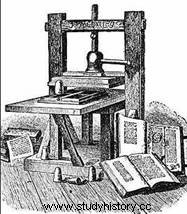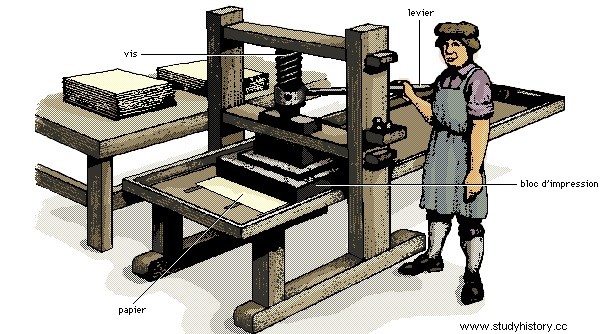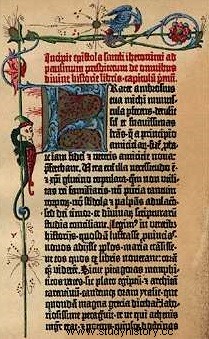 Johannes Gutenberg is considered the inventor of the printing press modern Western around 1454. Before him, it was the Chinese who first became interested in the concept of printing in order to simplify the use of their ideographic writing. In the 15th century, Gutenberg perfected a means of accelerating the speed of reproduction with two inventions:movable metal type and the hand press. From then on, the printing press was to contribute greatly to the rapid dissemination of knowledge, thought and ideas during the Renaissance. This invention will allow millions of books to spread around the world. The famous German, who died in poverty in 1468, never profited from his invention.
Johannes Gutenberg is considered the inventor of the printing press modern Western around 1454. Before him, it was the Chinese who first became interested in the concept of printing in order to simplify the use of their ideographic writing. In the 15th century, Gutenberg perfected a means of accelerating the speed of reproduction with two inventions:movable metal type and the hand press. From then on, the printing press was to contribute greatly to the rapid dissemination of knowledge, thought and ideas during the Renaissance. This invention will allow millions of books to spread around the world. The famous German, who died in poverty in 1468, never profited from his invention.
Books before Gutenberg
Men have constantly searched for the best way to preserve writings and have used clay tablets, papyri, and parchments. The first books appear in the first centuries of our era, when the Romans bind small wooden tablets covered with wax, which they then replace with sheets of parchment. Folded several times and sewn together, these sheets of parchment revolutionize the way of writing.
In the 2nd century AD. BC, the Chinese developed and widely spread the art of printing texts. The printing of designs and images on fabrics predated the printing of words in China by at least a century. The invention of paper in 105 and the expansion of the Buddhist religion favored the development of printing in China. Writing Materials traditional in the western world, papyrus and vellum, were not suitable for printing. Papyrus was too fragile to be used as a printing surface, while vellum, a thin surface made from animal skins, was too expensive a material. The paper was relatively strong and cheap.
As early as the 10th century, printing works were founded in Asia. They first practiced the technique of wood engraving, then from the 14th century that of movable metal characters.
In the Middle Ages, knowledge was only disseminated through the workshops of copyist monks, who “edited” numerous volumes intended for the high aristocracy, churches and monasteries. The first booksellers appeared in the 12th century and began to sell the work of the monks themselves, after having received authorization from the university authorities. In the 15th century, the demand for books increased significantly, and woodblock books began to be produced, made from engravings of each page in hardwood and then printed with a rudimentary press.
Around 1423 or 1437, the Dutchman Laurens Janszoon seems to have had the idea of cutting characters out of pieces of wood, but these turned out to be too fragile and deformed too much easily due to variations in hygrometry, that is to say the degree of humidity in the air.
Invention of the printing press by Johannes Gutenberg
It is necessary to wait around 1440 for the modern printing press to appear. We owe it to a German goldsmith named Johannes Gensfleisch dit Gutenberg. Born in Mainz between 1394 and 1399, he learned the trade of goldsmith, then moved to Strasbourg in 1430 where he set up a workshop for cutting precious stones before embarking on the manufacture of mirrors. Around 1436, Gutenberg began to take an interest in the reproduction of texts and embarked on the development of a new printing technique.
 With his partners, including Johann Fust and Peter Schöffer, he managed, after four long years of work, to manufacture reusable and interchangeable metal movable type, with an alloy of lead, tin and antimony, using an engraved mold with a punch in which the molten metal is poured. They then use these movable characters in a press, which they also invent, which is equipped with a movable carriage and a frame on which the sheet to be printed is placed. Finally, the ink used is oil-based. Thanks to this process, the whole of which was probably perfected around 1450, Johannes Gutenberg prepares the printing of his first book.
With his partners, including Johann Fust and Peter Schöffer, he managed, after four long years of work, to manufacture reusable and interchangeable metal movable type, with an alloy of lead, tin and antimony, using an engraved mold with a punch in which the molten metal is poured. They then use these movable characters in a press, which they also invent, which is equipped with a movable carriage and a frame on which the sheet to be printed is placed. Finally, the ink used is oil-based. Thanks to this process, the whole of which was probably perfected around 1450, Johannes Gutenberg prepares the printing of his first book.
This is the famous Biblia Sacra Latina in two columns, known as the “42-line Bible” or Gutenberg Bible, of which 48 copies survive today. Published in February 1455, it is printed in 300 copies and has 1,282 pages. Its success is immediate.
 As for the German printer, ruined by a lawsuit he lost against Fust, one of his former partners, who demanded reimbursement of his investments. He finally returned to Mainz in 1465 by Archbishop Adolf II of Nassau. It was in his hometown that he died on February 3, 1468, leaving behind him one of the most formidable inventions in history. Mainz has housed a museum since 1962 where his workshop and press have been reconstructed.
As for the German printer, ruined by a lawsuit he lost against Fust, one of his former partners, who demanded reimbursement of his investments. He finally returned to Mainz in 1465 by Archbishop Adolf II of Nassau. It was in his hometown that he died on February 3, 1468, leaving behind him one of the most formidable inventions in history. Mainz has housed a museum since 1962 where his workshop and press have been reconstructed.
Rapid spread of printing in Europe
It was in Mainz, in 1462, that a civil war would push the typographical workers, pupils of Johannes Gutenberg, to flee the episcopal city with fire and blood:they swarm in Europe. Printing flourished in the Holy Roman Empire, then in Italy, starting with the monastery of Subiaco, near Rome. Printing works are springing up in 150 cities, in Italy, France, Holland - countries where Laurent Coster, in Harleem, was once considered the inventor of the printing press. From 1455 to 1500, nearly 40,000 titles, incunabula, will be printed, despite a tiny literacy rate - it will be necessary to wait for the 19th century, a period of industrialization, and measures promoting education, for literacy to progress .
 France is not left out. In 1470, in the faculty of theology of the Sorbonne college in Paris, under the impetus of the intellectual Guillaume Fichet, a workshop was born thanks to the German master typographer Jean Heynlin. Another opened in Lyon in 1473, where more popular works were printed. In total in France, where François I imposes the Roman character, 30 printing works are born before the end of the century, including in villages, such as Bréhan-Loudéac in Brittany. The first book published in Paris, thanks to the printer of Germanic origin Ulrich Gering, ends with this enthusiastic colophon (final note), translated from Latin:"Just as the sun sheds light everywhere, so Paris, capital of the kingdom and nourisher of the Muses, you pour science on the world. Receive then as a reward this almost divine art of writing which Germany invented. »
France is not left out. In 1470, in the faculty of theology of the Sorbonne college in Paris, under the impetus of the intellectual Guillaume Fichet, a workshop was born thanks to the German master typographer Jean Heynlin. Another opened in Lyon in 1473, where more popular works were printed. In total in France, where François I imposes the Roman character, 30 printing works are born before the end of the century, including in villages, such as Bréhan-Loudéac in Brittany. The first book published in Paris, thanks to the printer of Germanic origin Ulrich Gering, ends with this enthusiastic colophon (final note), translated from Latin:"Just as the sun sheds light everywhere, so Paris, capital of the kingdom and nourisher of the Muses, you pour science on the world. Receive then as a reward this almost divine art of writing which Germany invented. »
The invention of the printing press revolutionizes thought
It is generally estimated that between 15 and 20 million copies were printed before 1500, these are the incunabula. Johannes Gutenberg's invention not only revolutionizes the way of reading (the texts are now more airy), but also has repercussions on the way of thinking since it allows direct access to biblical and ancient texts. Culture gradually emancipated itself from political and religious power, and humanist ideas spread throughout Europe.
 The printing press will thus considerably facilitate the dissemination of ideas and participate in particular in the Reformation and the emergence of Protestantism. We know that between 1517 and 1520, more than 300,000 copies of Luther's writings were distributed in Europe. Finally, it is the essential vector of the great cultural revolution that occurs during the Renaissance. However, the Church, through the blacklisting of especially religious works, will exercise censorship until the French Revolution, a period during which the printing press finally becomes free.
The printing press will thus considerably facilitate the dissemination of ideas and participate in particular in the Reformation and the emergence of Protestantism. We know that between 1517 and 1520, more than 300,000 copies of Luther's writings were distributed in Europe. Finally, it is the essential vector of the great cultural revolution that occurs during the Renaissance. However, the Church, through the blacklisting of especially religious works, will exercise censorship until the French Revolution, a period during which the printing press finally becomes free.
In 1971, Project Gutenberg was launched to provide a royalty-free digital version of works that had fallen into the public domain.
To go further
- Gutenberg and the invention of printing:An investigation, by Guy Bechtel. Fayard, 1992.
- Gutenberg's Europe:The Book and the Invention of Western Modernity (13th-16th Century), by Frédéric Barbier. Belin, 2006.
- The fabulous history of inventions - From mastery of fire to immortality. Dunod, 2018.
